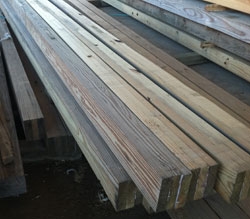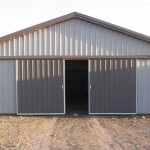Glu-laminated columns are a laminated composite product manufactured from high-strength lumber. By using multiple plies of materials, natural defects are randomized creating greater column strength and a higher degree of reliability.
 Hansen Pole Buildings provides glulam columns manufactured by several different companies, so there are some slight variations. This article will speak more to the commonalities between manufacturers and give a broad overview.
Hansen Pole Buildings provides glulam columns manufactured by several different companies, so there are some slight variations. This article will speak more to the commonalities between manufacturers and give a broad overview.
A fairly climate controlled environment is required for glulam fabrication, as the phenol resorcinol glues being used to join the end finger joints and individual plies together require a fairly stable temperature for proper curing.
Most post frame building glulam columns are manufactured from a #1 grade Southern Yellow Pine (SYP) lower portion, which is pressure preservative treated to UC-4B (structural in ground use) specifications and then kiln dried after treatment (KDAT) to moisture content of 15% or less.
The upper portions are most typically either #1 SYP or 1650 msr (machine stress rated) SPF (Spruce-Pine-Fir), either of which is kiln dried. Having the proper moisture content is critical to good adhesive bonding in the glue line.
Individual lower and upper members are finger jointed and the joint is glued together. Good finger joints are actually the most challenging part of the entire manufacturing process. Finger jointing allows for columns to be fabricated up to (depending upon the manufacturer) 64 feet in length, with no butt (square-end to square-end) joints.
Once the joints have cured, each member must be planed. This opens up the wood cells to accept the phenol resorcinol glue uniformly. Each member is then run through a planer which reduces the thickness of the board to from 1-1/2 inches as it was originally milled, to 1-3/8 inches.
The plies are then face glued and secured into presses where they are squeezed under pressure. Once the glue has cured, the columns are removed from the presses and planed to remove excess glue and any abnormalities.
After this final planing, a glulam made from three 2x members will typical measure about 4-1/8 inches in width. For a 2×6 the final depth will be 5-3/8 inches. A 2×8 will be 7-1/8 inches in depth. Four plies will be about 5-1/2 inches in width. While custom dimensions can be created by planing down larger members, the utilization of these dimensions creates the least possible waste and allows for the most value for the investment.
What I like about glulams is they have a high strength to weight ratio (comparing lumber grade to same lumber grade). I can move a good sized glulam beam by myself, or with a buddy, without having to get out the heavy equipment.








